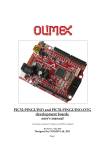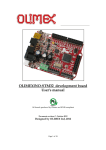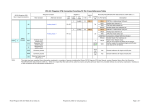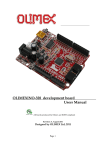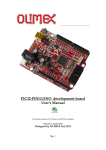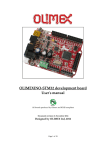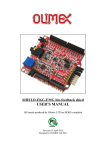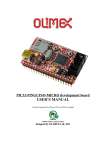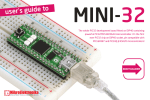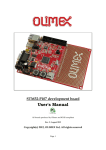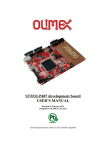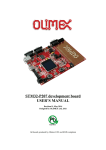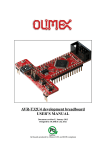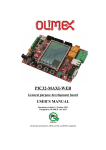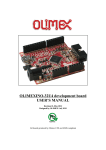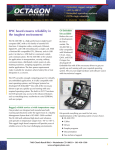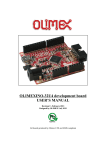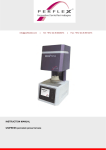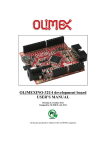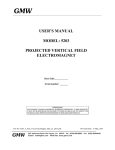Download PIC32-PINGUINO and PIC32-PINGUINO-OTG
Transcript
PIC32-PINGUINO and PIC32-PINGUINO-OTG development boards user's manual All boards produced by Olimex are ROHS compliant Revision E, October 2013 Designed by OLIMEX Ltd, 2011 Page 1 INTRODUCTION: What is Arduino? Arduino is an open-source electronics prototyping platform, designed to make the process of using electronics in multidisciplinary projects more accessible. The hardware consists of a simple open hardware design for the Arduino board with an Atmel AVR processor and on-board I/O support. The software consists of a standard programming language and the boot loader that runs on the board. Arduino hardware is programmed using a Wiring-based language (syntax + libraries), similar to C++ with some simplifications and modifications, and a Processing-based IDE. The project began in Ivrea, Italy in 2005 to make a device for controlling student-built interaction design projects less expensively than other prototyping systems available at the time. As of February 2010 more than 120,000 Arduino boards had been shipped. Founders Massimo Banzi and David Cuartielles named the project after a local bar named Arduino. The name is an Italian masculine first name, meaning "strong friend". The English pronunciation is "Hardwin", a namesake of Arduino of Ivrea. More information could be found at the creators web page http://arduino.cc/ and in the Arduino Wiki http://en.wikipedia.org/wiki/Arduino To make the story short - Arduino is easy for the beginners with lack of Electronics knowledge, but also do not restrict the professionals as they can program it in C++ or mix of Arduino/C++ language. There are thousands of projects which makes the startup easy as there is barely no field where Arduino enthusiasts to have not been already. Arduino has inspired two other major derivatives - MAPLE and PINGUINO. Based on 8-bit AVR technology the computational power of Arduino boards are modest, this is why team from MIT developed MAPLE project which is based on ARM7 STM32F103RBT6 microcontroller, the board have same friendly IDE as Arduino and offers the same capabilities as hardware and software but runs the Arduino code much faster. Maple project can be found at http://leaflabs.com In parallel with Arduino another project was started called PINGUINO. This project choose the first implementation to be with PIC microcontrollers, the reason was that AVRs were hard to find in some parts of the world like South America so you will see lot of PINGUINO developers are from there. PINGUINO project founders decided to go with Python instead Java for processing language. For the moment PINGUINO is much more flexible than Arduino as not limited to 8bit, currently the IDE which have GCC in background can support 8-bit PIC microcontrollers, 32bit PIC32 (MIPS) microcontrollers and ARM7/CORTEXM3 microcontrollers which makes PINGUINO very flexible as once you make your project you can migrate easily through different hardware platforms and not being connected to single microcontroller manufacturer. The PINGUINO project can be found at http://www.pinguino.cc Page 2 BOARD FEATURES: We entered the Arduino/MAPLE field 5 years after the introductions of the design, and this allowed us to see and skip most of the errors the Arduino inventors did :-) We had the possibility to read current customer feedback and to implement what they wanted to see in the original Arduino. 1. The original Arduino/Maple uses linear power supply, this limits the input voltage range. We designed the power supply to accept power in the 9 to 30V DC range thus making it possible to take virtually any power supply adapter on the market; this also enables application which are in industrial power supply 24VDC. 2. We carefully selected all components to work reliable in the INDUSTIRAL temperature range -25+85C so the board can be used in INDUSTIRAL applications while the original design is up to the commercial 0-70C operating temperature. 3. The original Arduino/MAPLE design is not good for portable applications as consumes too much power with the linear voltage regulators, we put ULTRA LOW POWER voltage regulators and the consumption is only few microamps, which enables hand-held and battery powered applications. 4. We added Li-Ion rechargeable battery power supply option with BUILD-IN on board charger, so when you attach battery it is automatically charged and kept in this state until the other power source (USB or external adapter) is removed and it will AUTOMATICALLY power the board - no jumpers, no switches! 5. Our board has UEXT connector which allows many existing modules like RF, ZIGBEE, GSM, GPS to be connected. 6. Our board has SD-MMC card for data logging. 7. Our board has USB-OTG hardware. 8. Our design allows RTC - Real Time Clock. 9. We made our design noise immune. 10. Optionally if someone needs higher precision and temperature stability in Analog reading we have provisioned the board with Aref precise source. 11. The LEDs and the BUTTONs are on the edge of the board so that there is easy access even if the boards have shields mounted. 12. All components are LOWER than the connectors, so the shields do not interfere with them. 13. Mini USB connector is used which is common and used in most cell phones, so you do not have to buy other cables. 14. Original Arduino design had flaw and the connectors were not spaced at 0.1" thus making the usage of proto boards impossible, to keep the compatibility we have same spacing but we also added next to it a connector with 0.1" step which customers can use with perforated boards. Page 3 15. All signals on the connectors are printed on the top and on the bottom of the board, so when you check with probe you know exactly which port you are measuring. 16. 4 mount holes to make board attachment easier. ELECTROSTATIC WARNING: The PIC32-PINGUINO and PIC32-PINGUINO-OTG boards are shipped in protective anti-static packaging. The boards must not be subject to high electrostatic potentials. General practice for working with static sensitive devices should be applied when working with these boards. BOARD USE REQUIREMENTS: Cables: Mini USB cable For programming via ICSP connector you will need PIC-ICSP connector and USB A-B cable for, PIC-KIT3. Hardware: Programmer/Debugger – PIC-KIT3, or other compatible programming/debugging tool. !!!Warning!!! PIC-ICD2, PIC-ICD2-POCKET and PIC-ICD2-TINY are not supported nor recommended. They lack software support in newer MPLABs MAIN DIFFERENCES BETWEEN THE TWO BOARDS: The main difference between PIC32-PINGUINO and PIC32-PINGUINO-OTG is the USB connector. The first board has a standard USB connector that is configured as a device which allows the board to communicate only with hosts. The PIC32PINGUINO-OTG can be configured either as a device or a host – which allows the board to communicate with devices also – e.g. USB smartphones, keyboards, mice etc. Page 4 SCHEMATICS: PIC32-PINGUINO R1 100nF SR1 NA(AP431SA) A C8 20pF C9 2 7pF GND2 GND1 USB GND4 GND3 USB_POWER DD+ 1N5819S/SS14 D1 Q2 32.768 kHz/6pF C10 27pF 3.3V GND AVSS VSS VSS VSS 39 40 48 47 Q1 USB_DEVICE VBUS DD+ ID GND 20 9 25 41 100nF 2 0pF Q8.000MHz/HC-49S/20pF/20ppm/PTH +5V USB C6 C7 GND R7 NA C5 100nF OSC1/CLKI/RC12 OSC2/CLKO/RC15 SOSCO/T1CK/CN0/RC14 SOSCI/CN1/RC13 60 61 62 63 64 1 2 3 CON3-1 CON3-2 CON3-3 CON3-4 CON3-5 CON3-6 CON3-7 CON3-8 NA(GPH127/SMT /02x10) RE0/PMD0 RE1/PMD1 RE2/PMD2 RE3/PMD3 RE4/PMD4 RE5/PMD5 RE6/PMD6 RE7/PMD7 35 34 VUSB VBUS D-/RG3 D+/RG2 D- 36 D+ 37 MINI-USB C13 10nF C11 C1 2 10 0nF 100nF 4 5 6 8 D13(SCK/LED1) D12(MISO) D11(MOSI) D10(#SS) OC1/INT0/RD0 #U1RTS/OC2/RD1 U1RX/OC3/RD2 U1TX/OC4/RD3 OC5/IC5/PMWR/CN13/RD4 PMRD/CN14/RD5 CN15/RD6 CN16/RD7 RTCC/IC1/INT1/RD8 #U1CTS/SDA1/IC2/INT2/RD9 SCL1/IC3/PMCS2/PMA15/INT3/RD10 IC4/PMCS1/PMA14/INT4/RD11 46 49 50 51 52 53 54 55 42 43 44 45 D2(BUT) LED2 D0(RXD1) D1(TXD1) D2(BUT) D3 D4 D5 D6 A4(SDA1) A5(SCL1) D7 3.3V_AVCC CON3-20 CON3-19 CON3-18 CON3-17 CON3-16 CON3-15 CON3-14 1 2 3 4 5 6 VIN NA CON2 1 2 3 4 5 6 A0 A1 A2 A3 A4(SDA1) A5(SCL1) D0(RXD1),D1(TXD1),D2(BUT ),D[3..7] D2(BUT) NA CON4 D0(RXD1) D1(TXD1) D2(BUT) D3 D4 D5 D6 1 2 3 4 5 6 7 8 D0(RXD1) D1(TXD1) D2(BUT) D3 D4 D5 D6 D7 D7 RG6/SCK2/PMA5/CN8 RG7/SDI2/PMA4/CN9 RG8/SDO2/PMA3/CN10 RG9/#SS2/PMA2/CN11 RX2 TX2 CON3-10 CON3-9 1-2->close 2 1 2 3 4 5 6 7 8 D10(#SS) UEXT_#CS 2 D13(SCK/LED1) 3.3V NA D8,D9(LED2),D10(#SS),D11(MOSI),D12(MISO),D13(SCK/LED1),UEXT_#CS LED2 Close R9 330R R10 330R LED1 GREEN(GYX-SD-TC0805SGC) TX2 A5(SCL1) D12(MISO) D13(SCK/LED1) 1 3 5 7 9 2 4 6 8 10 RX2 A4(SDA1) D11(MOSI) UEXT_#CS R12 4.7k X1-1 PWR_J VR2(3.3V) D11(MOSI) UEXT_#CS NA(MCP17 00T -3302E/MB) 2 C14 NA(2.2uF) BUTTONS VIN VOUT 3 3.3V C15 GND 3.3V NA(2.2uF) POWER_SUPPLY 0.47R R15 R16 4.7k 0.47R D3 R21 1k/1% 15k appr. 70 mA charge current 5 C30 2.2uF - C19 2.2uF 1 2 3.7V-LI_BAT DW02R R22 0R 0R(NA) C28 1 SW-SIDE_WTCM-TR(3X4) FB1206 C27 VSS PROG R23 3 3 10nF 2 VDD VBAT BAT TERYCE CHARGER R25 4.7k GND 10uF/6.3V 4 VOUT 1 C26 M CP73812T -420I/OT C29 FET1 IRLML 6402 +5V U3 C25 +5V 100nF Battery Charger R24 330R C24 L2 10uF/6.3V R18 3k/1% VIN 1N5819S/SS14 + C18 2.2uF MC33063ADR(SO8) 1N5819S/SS14 2 D6 RED(GYX-SD-TC0805SGC) U2 D5 3.3V_AVCC MCP1700T -3302E/MB 3.3V D4 1N5819S/SS14 5V 10uF/6.3V 5 L1 CL10 uH SW68 VR1(3.3V) PWR_LED FB 1 2 + SC SE C E 4 7 0 u F/1 0 V /6 .3 x1 1 m m /R M 2 .5 IS DC 7 8 VSS TC R17 4.7k D2 1N4148/m in i-melf D2(BUT) RESET +5V 4 C23 820pF + C17 3 100nF CE 100uF/35V/6.3x11mm/RM2.5 C16 X1-2 NA VCC 6 1N5819S/SS14 YDJ-1136 9-30VDC RESET VCC GND PGD PGC PGM 3.3V_AVCC R13 33k 1 R14 33R PGED2 PGEC2 BH10R VIN R8 3.3V 3.3V UEXT R11 4.7k LED2 YELLOW(GYX-SD-TC0805SYC) RESET UEXT 3.3V D8 D9 D10 D11 D12 D13 GND AREF RST R19 330R C21 4.7nF SW-SIDE_WTCM-TR(3X4) 1 D0 D1 D2 D3 D4 D5 D6 D7 NA D8 D9 D10(#SS) D11(MOSI) D12(MISO) D13(SCK/LED1) GND AREF 3.3V LEDS A0 A1 A2 A3 A4 A5 CON5 58 59 33 31 32 RF0 RF1 USBID/RF3 SDA2/U2RX/PMA9/CN17/RF4 SCL2/U2TX/PMA8/CN18/RF5 PIC32MX440F256H-80I/PT LED1_E RST 3V3 5V GND GND VIN POWER CON3-13 PGEC2 PGED2 R4 33R A4(SDA1) R5 33R A5(SCL1) A7 3.3V A6 +5V CON3-12 CON3-11 VIN D8 D9 ANALOG C4 100nF CON1 RESET 3.3V +5V DIGITAL C R C3 10 0nF AREF A0 A1 A2 A3 DIGITAL R6 NA C2 16 15 14 13 12 11 17 18 21 22 23 24 27 28 29 30 ICSP C1 PGED1/AN0/VREF+/CVREF+/PMA6/CN2/RB0 PGEC1/AN1/VREF-/CVREF-/CN3/RB1 AN2/C2IN-/CN4/RB2 AN3/C2IN+/CN5/RB3 AN4/C1IN-/CN6/RB4 AN5/C1IN+/VBUSON/CN7/RB5 PGEC2/AN6/OCFA/RB6 PGED2/AN7/RB7 AN8/#U2CTS/C1OUT/RB8 AN9/C2OUT/PMA7/RB9 TMS/AN10/CVREFOUT/PMA13/RB10 TDO/AN11/PMA12//RB11 TCK/AN12/PMA11/RB12 TDI/AN13/PMA10/RB13 AN14/#U2RTS/PMALH/PMA1/RB14 AN15/OCFB/PMALL/PMA0/CN12/RB15 1 R3 NA AREF + R2 NA #MCLR VCAP/VDDCORE ENVREG VDD VDD VDD AVDD ARDUINO_PLATFORM A[0..3] 0R(NA) 3 3.3V_AVCC 10uF/6.3V/0805 VIN 7 56 57 10 26 38 19 AREF 0R U1 RESET ARDUINO: PLATFORM & CONNECTORS 3.3V_AVCC G9/F0 3.3V VOLTAGE_REFERENCE BUT R20 330R C20 NA(100nF) PIC32-PINGUINO_rev_B1 OLIMEX LTD, BULGARIA, 2012 https://www.olimex.com PIC32-PINGUINO-OTG GND2 GND1 D1 USB GND4 GND3 +5V_VBUS DD+ USB_ID 1N5819S/SS14 +5V VBUS DD+ ID GND 20 pF C9 27pF Q2 32.768 kHz/6pF 27 pF C10 3.3V GND CON3-1 CON3-2 CON3-3 CON3-4 CON3-5 CON3-6 CON3-7 CON3-8 NA(GPH127/SM T/0 2x10) OSC1/CLKI/RC12 OSC2/CLKO/RC15 SOSCO/T1CK/CN0/RC14 SOSCI/CN1/RC13 60 61 62 63 64 1 2 3 RE0/PMD0 RE1/PMD1 RE2/PMD2 RE3/PMD3 RE4/PMD4 RE5/PMD5 RE6/PMD6 RE7/PMD7 35 34 C12 C13 100nF 2.2uF FB1 100 nF FB0805/600R/200mA(201209-601) 4 5 6 8 D13(SCK/LED1) D12(MISO) D11(MOSI) D10(#SS) OC1/INT0/RD0 #U1RTS/OC2/RD1 U1RX/OC3/RD2 U1TX/OC4/RD3 OC5/IC5/PMWR/CN13/RD4 PMRD/CN14/RD5 CN15/RD6 CN16/RD7 RTCC/IC1/INT1/RD8 #U1CTS/SDA1/IC2/INT2/RD9 SCL1/IC3/PMCS2/PMA15/INT3/RD10 IC4/PMCS1/PMA14/INT4/RD11 VUSB VBUS D-/RG3 D+/RG2 46 49 50 51 52 53 54 55 42 43 44 45 D2(BUT) LED2 D0(RXD1) D1(TXD1) D2(BUT) D3 D4 D5 D6 A4(SDA1) A5(SCL1) D7 CON1 3.3V_AVCC CON3-20 CON3-19 CON3-18 CON3-17 CON3-16 CON3-15 CON3-14 3.3V 33R A4(SDA1) +5V 33R A5(SCL1) A7 VIN A6 V_BAT D8_MMC_#SS CON3-12 D9 USB_FAULT VIN D2(BUT) 1 2 3 4 5 6 NA CON4 D0(RXD1) D1(TXD1) D2(BUT) D3 D4 D5 D6 D0(RXD1) D1(TXD1) D2(BUT) D3 D4 D5 D6 D7 D7 1 2 3 4 5 6 7 8 RG6/SCK2/PMA5/CN8 RG7/SDI2/PMA4/CN9 RG8/SDO2/PMA3/CN10 RG9/#SS2/PMA2/CN11 E_MEASUREMENT USB_ID RX2 TX2 1 -2->clo se CON3-10 2 CON3-13 CON3-11 D8_MMC_#SS D9 D10(#SS) D11(MOSI) D12(MISO) D13(SCK/LED1) GND AREF D10(#SS) UEXT_#CS D8,D9(LED2),D10(#SS),D11(MOSI),D12(MISO),D13(SCK/LED1),UEXT_#CS 2 D13(SCK/LED1) LED2 Close R9 330R R10 330R LED1 GREEN(GYX-SD-TC0805SGC) 3.3V UEXT R11 4.7k 1 3 5 7 9 TX2 A5(SCL1) D12(MISO) D13(SCK/LED1) LED2 YELLOW(GYX-SD-TC0805SYC) UEXT 3.3V 1 2 3 4 5 6 7 8 2 4 6 8 10 RX2 A4(SDA1) D11(MOSI) UEXT_#CS R12 4.7k R45 R46 R13 33k R47 R48 R49 L3 D11(MOSI) UEXT_#CS 1MD8_ MMC_#SS 10k D11(M OSI) 100k 100k 100k 2 3 6 4 5 7 8 1 D13(SCK/LED1) D12(MISO) CL470nH/0805/1.76R/250mA R8 33R PGED2 PGEC2 CD/DAT3/CS CMD/DI VSS VDD CLK/SCLK DAT0/DO DAT1/RES DAT2/RES SD/MMC MICRO C22 47uF/6.3V/TANT BH10R D8 D9 D10 D11 D12 D13 GND AREF NA RESET SD/MMC 3.3V 3.3V + 1 3.3V D0 D1 D2 D3 D4 D5 D6 D7 NA 3.3V LEDS A0 A1 A2 A3 A4 A5 CON5 58 59 33 31 32 RF0 RF1 USBID/RF3 SDA2/U2RX/PMA9/CN17/RF4 SCL2/U2TX/PMA8/CN18/RF5 PIC32MX440F256H-80I/PT LED1_E RST 3V3 5V GND GND VIN NA CON2 A0 A1 A2 A3 A4(SDA1) A5(SCL1) D0 (RXD1),D1(T XD1),D2(BUT ),D[3..7] CON3-9 1 2 3 4 5 6 RESET 3.3V +5V RESET VCC GND PGD PGC PGM BUTTONS 3.3V 15k appr. 70 mA charge current R28 5 C30 - 3M 1 2 3.7 V-LI_BAT DW0 2R E_MEASUREMENT R FB1 206 R22 0R 0R(NA) A R7 NA SR1 D2 1N4148/mi ni-me lf R17 4.7k D2(BUT) RESET RST R19 330R C21 4.7nF SW-SIDE_WTCM-TR(3X4) 3 R6 NA C C28 1 GND C26 VSS PROG R23 3 1 C25 2 VDD VBAT BAT T ERYCE CHARGER VOUT V_BAT L2 100nF 4 R25 4.7k VIN 1N5819S/SS14 C19 M CP73812T -420I/OT C29 FET1 IRLML6402 +5V U3 2.2uF R21 1k/1% +5V R29 R18 3k/1% Battery Charger R24 330R C24 + + C18 2.2uF 1N5819S/SS14 2.2uF MC33063ADR(SO8) D5 3.3V_AVCC MCP17 00T -3302E/MB 3.3V R16 4.7k R3 NA AREF NA(2.2uF) 2 D6 10uF/6.3V 5 R2 NA C15 VR1(3.3V)_D D4 1N5819S/SS14 5V RED(GYX-SD-TC0805SGC) U2 L1 CL10uH SW68 PWR_LED FB 1 2 CE 470uF/10V/6.3x11mm/RM2.5 SC SE 3 10uF/6.3V 7 8 IS DC 6 VCC C23 VSS TC GND SW-SIDE_WTCM-TR(3X4) NA(2.2uF) +5V 4 + C17 3 820pF CE 100uF/35V/6.3x11mm/RM2.5 C16 X1-2 NA 100nF YDJ-1136 9-30VDC 1 C27 C14 1N5819S/SS14 3.3V VIN VOUT 0.47R NA(AP431SA) 2 10nF POWER_SUPPLY 0.47R R15 D3 3.3V_AVCC NA(MCP1700T -3 302E/M B) 1M PWR_J VR2(3.3V)_A VOLTAGE_REFERENCE VIN 3.3V_AVCC 10uF/6.3V R14 10nF C32 VIN X1-1 POWER AREF A0 A1 A2 A3 VBUSON PGEC2 PGED2 R4 R5 ANALOG C5 10uF/6.3V C4 10uF/6.3V C8 AVSS VSS VSS VSS 39 40 48 47 D- 36 D+ 37 C11 USB-OTG 20pF Q8.000MHz/HC-49S/20pF/20ppm/PTH Q1 VBUSON 4 7k 1 0k 20 9 25 41 100nF C7 GND T1 DTC114YKA C6 16 15 14 13 12 11 17 18 21 22 23 24 27 28 29 30 DIGITAL USB_FAULT LM3 526M -L(SO8) USB C3 10uF/6.3V 100nF ARDUINO_PLATFORM A[0..3] PGED1/AN0/VREF+/CVREF+/PMA6/CN2/RB0 PGEC1/AN1/VREF-/CVREF-/CN3/RB1 AN2/C2IN-/CN4/RB2 AN3/C2IN+/CN5/RB3 AN4/C1IN-/CN6/RB4 AN5/C1IN+/VBUSON/CN7/RB5 PGEC2/AN6/OCFA/RB6 PGED2/AN7/RB7 AN8/#U2CTS/C1OUT/RB8 AN9/C2OUT/PMA7/RB9 TMS/AN10/CVREFOUT/PMA13/RB10 TDO/AN11/PMA12//RB11 TCK/AN12/PMA11/RB12 TDI/AN13/PMA10/RB13 AN14/#U2RTS/PMALH/PMA1/RB14 AN15/OCFB/PMALL/PMA0/CN12/RB15 DIGITAL 100nF 1 #ENA OUT_A 2 FLAG_A IN FLAG_B 3 GND #ENB 4 OUT_B C2 #MCLR VCAP/VDDCORE ENVREG VDD VDD VDD AVDD ICSP C31 C1 R27 R26 U4 7 56 57 10 26 38 19 1 8 7 6 5 10uF/6.3V 10k 10k 3.3V 3.3V RESET Designed by Olimex_LTD AREF 0R 0R(NA) 3 USB_OTG +5V R1 U1 ARDUINO: PLATFORM & CONNECTORS 3.3V_AVCC G9/F0 3.3V BUT R20 330R C20 NA(100nF) PIC32-PINGUINO-OTG_rev_D OLIMEX LTD 2012 https://www.olimex.com BOARD LAYOUT: Page 7 POWER SUPPLY CIRCUIT: PIC32-PINGUINO/-OTG can take power supply from: – external power supply (9-30) VDC. – + 5V from USB – 3.7 V Li-ion battery The programmed board power consumption is about 100 mA with all peripherals enabled. RESET CIRCUIT: PIC32-PINGUINO/-OTG reset circuit includes D2 (1N4148), R16 (4.7kΩ), R19 (330Ω), C21 (4.7nF), PIC32MX440F256H pin 7 (#MCLR) and RESET button. CLOCK CIRCUIT: Quartz crystal Q1 8 MHz is connected to PIC32MX440F256H pin 39 (OSC1/CLKI/RC12) and pin 40 (OSC2/CLKO/RC15). Quartz crystal Q2 32.768 kHz is connected to PIC32MX440F256H pin 47 (SOSCI/CN1/RC13) and pin 48 (SOSCO/T1CK/CN0/RC14). Page 8 JUMPER DESCRIPTION: LED1_E This jumper, when closed, enables LED1. Default state is closed. G9/F0 This jumper, when is in position G9 – connects UEXT pin 10 (UEXT_#CS) to CON5 pin 3 (D10(#SS)) and when is on position F0 – connects UEXT pin 10 (UEXT_#CS) to PIC32MX440F256H pin 58 (RF0). Default state is in position F0. INPUT/OUTPUT: Status Led with name LED1 (green) connected via jumper LED1_E to PIC32MX440F256H pin 4 (RG6) – signal D13(SCK/LED1). Status Led with name LED2 (yellow) connected to PIC32MX440F256H pin 49 (#U1RTS/OC2/RD1). Power-on LED (red) with name PWR_LED – this LED shows that the board is power supplied. User button with name BUT connected to PIC32MX440F256H pin 46 (OC1/INT0/RD0) and pin 52 (OC5/IC5/PMWR/CN13/RD4) – signal D2(BUT). Note that you should be careful with D2 signal on the digital connector since it goes to two microcontroller pins. User button with name RST connected to PIC32MX440F256H pin 7 (#MCLR). Page 9 EXTERNAL CONNECTORS DESCRIPTION: ICSP: Pin # Signal Name 1 RESET 2 +3.3V 3 GND 4 PGED2 5 PGEC2 6 Not connected UEXT: Pin # Signal Name 1 +3.3V 2 GND 3 TX2 4 RX2 5 A5(SCL1) 6 A4(SDA1) 7 D12(MISO) 8 D11(MOSI) 9 D13(SCK/LED1) 10 UEXT_#CS Page 10 CON1 – POWER: Pin # Signal Name 1 RESET 2 +3.3V 3 +5V 4 GND 5 GND 6 VIN CON2 – ANALOG: Pin # Signal Name 1 A0 2 A1 3 A2 4 A3 5 A4(SDA1) 6 A5(SCL1) PWR_JACK: Pin # Signal Name 1 Power Input 2 GND Page 11 CON4 – DIGITAL: Pin # Signal Name 1 D0(RXD1) 2 D1(TXD1) 3 D2(BUT) 4 D3 5 D4 6 D5 7 D6 8 D7 CON5 – DIGITAL: Pin # Signal Name 1 D8_MMC_#SS 2 D9 3 D10(#SS) 4 D11(MOSI) 5 D12(MISO) 6 D13(SCK/LED1) 7 GND 8 AREF LI_BAT: Pin # Signal Name 1 VBAT 2 GND Page 12 USB-OTG (On-The-Go): Note that it is present only in the PIC32-PINGUINO-OTG version Pin # Signal Name 1 +5V_VBUS 2 D- 3 D+ 4 USB_ID 5 GND SD/MMC: Pin # Signal Name 1 MCIDAT2 2 D8_MMC_#SS 3 D11(MOSI) 4 +3.3V 5 D13(SCK/LED1) 6 GND 7 D12(MISO) 8 MCIDAT1 9 Not connected 10 Not connected 11 Not connected 12 Not connected Page 13 CON3: Pin # Signal Name Pin # Signal Name 1 RE0 2 RE1 3 RE2 4 RE3 5 RE4 6 RE5 7 RE6 8 RE7 9 LED2 10 RF1 11 TX2 12 RB12 13 RX2 14 VIN 15 GND 16 +5V 17 +3.3V 18 GND 19 AGND 20 VDD Note: This connector is not mounted on the board. Page 14 MECHANICAL DIMENSIONS: Page 15 AVAILABLE DEMO SOFTWARE: There are numerous projects available in the software section of PIC32-PINGUINO and PIC32-PINGUINO-OTG web pages: https://www.olimex.com/Products/Duino/PIC32/PIC32-PINGUINO/ https://www.olimex.com/Products/Duino/PIC32/PIC32-PINGUINO-OTG/ Page 16 ORDER CODE: PIC32-PINGUINO – fully assembled and tested board PIC32-PINGUINO-OTG – fully assembled and tested board How to order? You can order to us directly or by any of our distributors. Check our web https://www.olimex.com/ for more info. Revision history: Board's revision Rev. C, March 2011 Rev. D, March 2012 – Changed various names on the top and the bottom of the board – – Removed C14 - 2.2uF, C15 - 2.2uF, VR2-MCP1700T-3302E/MB; Added L2FB1206 – because of random hangs of the PIC32 in specific cases Removed C20 – was filtering not only the button bounce but some of the higher frequencies which we decided to change Manual's revision Rev. A, August 2011 – At first page “Copyright(c) 2011, OLIMEX Ltd, All rights reserved” is replaces with “Designed by OLIMEX Ltd., 2011” – In schematic “COPYRIGHT(C) 2011, OLIMEX Ltd.” replaced with “DESIGNED BY OLIMEX LTD, 2011” Rev. B, October 2011 – In “BOARD USE REQUIREMENTS” added more information about cables; “Hardware” and “Warning” – The picture for USB on-the-go connector is changed Rev. C, March 2012 – Removed “10 .We use separate voltage regulator for the Analog part, which allow the ADC to be read correctly without the digital noise pickup.” – Updated schematic with board version D – Various spelling changes and page formatting Rev. D, October 2012 – Adjusted the manual for both PIC32-PINGUINO and PIC32-PINGUINO-OTG – Updated disclaimer – Updated schematic with board version D Page 17 – Various spelling changes and page formatting Rev E October 2013 – Added additional note about the D2 signal to make it more obvious. – Updated disclaimer Page 18 © 2013 Olimex Ltd. Olimex®, logo and combinations thereof, are registered trademarks of Olimex Ltd. Other product names may be trademarks of others and the rights belong to their respective owners. The information in this document is provided in connection with Olimex products. No license, express or implied or otherwise, to any intellectual property right is granted by this document or in connection with the sale of Olimex products. The Hardware project is released under the Creative Commons Attribution-Share Alike 3.0 United States License. You may reproduce it for both your own personal use, and for commertial use. You will have to provide a link to the original creator of the project http://www.olimex.com on any documentation or website. You may also modify the files, but you must then release them as well under the same terms. Credit can be attributed through a link to the creator website: http://www.olimex.com The software is released under GPL. It is possible that the pictures in this manual differ from the latest revision of the board. The product described in this document is subject to continuous development and improvements. All particulars of the product and its use contained in this document are given by OLIMEX in good faith. However all warranties implied or expressed including but not limited to implied warranties of merchantability or fitness for purpose are excluded. This document is intended only to assist the reader in the use of the product. OLIMEX Ltd. shall not be liable for any loss or damage arising from the use of any information in this document or any error or omission in such information or any incorrect use of the product. This evaluation board/kit is intended for use for engineering development, demonstration, or evaluation purposes only and is not considered by OLIMEX to be a finished end-product fit for general consumer use. Persons handling the product must have electronics training and observe good engineering practice standards. As such, the goods being provided are not intended to be complete in terms of required design-, marketing-, and/or manufacturing-related protective considerations, including product safety and environmental measures typically found in end products that incorporate such semiconductor components or circuit boards. Olimex currently deals with a variety of customers for products, and therefore our arrangement with the user is not exclusive. Olimex assumes no liability for applications assistance, customer product design, software performance, or infringement of patents or services described herein. THERE IS NO WARRANTY FOR THE DESIGN MATERIALS AND THE COMPONENTS USED TO CREATE PIC32-PIGNUINO. THEY ARE CONSIDERED SUITABLE ONLY FOR PIC32-PINGUINO. Page 19



















